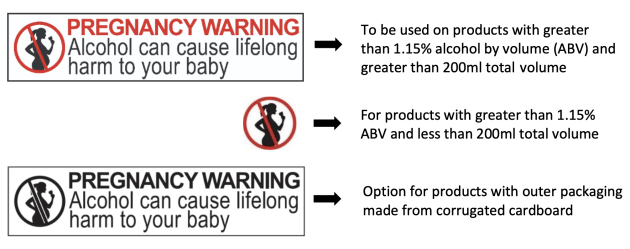A study by The George Institute for Global Health has found only 63 per cent of alcohol products in Australia displayed the mandatory pregnancy warning label, despite being given a three-year period to phase in.
Published in the Australian and New Zealand Journal of Public Health, the research analysed around 6000 alcohol products sold in four large stores in Sydney from June to November 2023.
Health experts are concerned that the alcohol industry may be deliberately delaying the inclusion of government-mandated pregnancy warnings across its products, as companies were given three years, from 31 July 2020 to 31 July 2023, to implement the label changes.
The warning labels are intended to ensure consumers are informed that drinking while pregnant increases the risk of potential life-long health issues in unborn children. Alcohol can cause low birth weight, premature birth, and foetal alcohol spectrum disorder (FASD) in unborn babies, and potentially lead to lifelong physical, cognitive, developmental and behavioural problems.
Lead author and lecturer at UNSW Sydney Faculty of Medicine, Professor Simone Pettigrew, said the research demonstrates the need for improved alcohol health warning regulation and more thorough Government monitoring to protect babies’ health.
“The industry fought hard against pregnancy warning labels when they were mandated by the government in 2020, after 20 years of lobbying to bring Australia in line with the evidence and WHO recommendations,” said Pettigrew.
“Yet, even with three years to display standardised pregnancy warnings on all new packaging, more than a third of products we analysed did not do so. Most alarmingly, only half of spirits, which have the highest levels of alcohol by volume, showed the pregnancy warning.
“Our analysis purposely straddled the end of the transition period, and the results suggest that alcohol companies may have deliberately used the phase-in period as a loophole to delay introducing mandated pregnancy warnings for fear of losing sales,” she said.
Past studies have demonstrated that some Australian women remain confused about whether they can drink alcohol while pregnant, with around one-third of women saying they have, according to the Australian Institute of Health and Welfare. Giving women warning information has been shown to motivate them to avoid drinking while pregnant.

The analysis found that 25 per cent of alcohol products carried their own versions of pregnancy warnings instead of the standardised label. Pettigrew stated this is a concern, with research consistently showing industry-designed warnings are less effective than warnings developed using evidence-based approaches.
Considering Food Standards Australia New Zealand is currently working on proposals to introduce energy, carbohydrate and sugar content information on alcoholic beverage labels, the inability of the industry to adopt the pregnancy warning promptly does not look promising.
Public Health Association of Australia CEO, Adjunct Professor Terry Slevin, said the George Institute’s study confirmed government must take much stronger action on alcohol warnings to help Australians make informed choices about their drinking and reduce the harms it causes in the community.
“This latest research shows that the alcohol industry has no interest in protecting the health of Australians and will avoid and delay introducing mandated health warnings until the last minute and beyond.
“As we approach the federal election, public health experts are asking the next Australian Government to take meaningful action on obesity, including the marketing of unhealthy food and beverages and mandating Health Star Ratings on packaged foods. We also want to see kilojoule labelling on alcohol so people can see how much alcoholic beverages contribute to the energy they consume – and so the potential contribution to their waistline,” he said.
“The message from this research is that we can’t rely on the food and beverage industry to self-regulate the labels of their unhealthy products and when new regulation is introduced, we shouldn’t allow for generous phase in periods which they might exploit,” he said.






